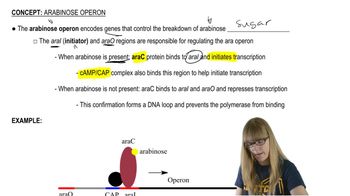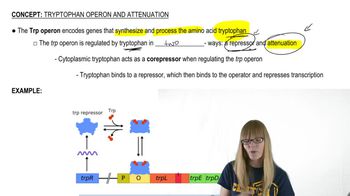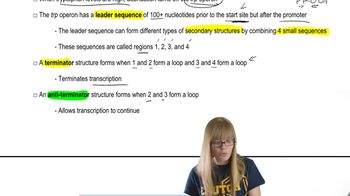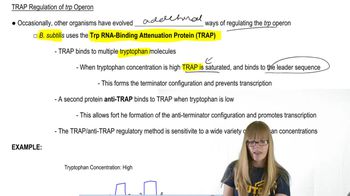Table of contents
- 1. Introduction to Genetics51m
- 2. Mendel's Laws of Inheritance3h 37m
- 3. Extensions to Mendelian Inheritance2h 41m
- 4. Genetic Mapping and Linkage2h 28m
- 5. Genetics of Bacteria and Viruses1h 21m
- 6. Chromosomal Variation1h 48m
- 7. DNA and Chromosome Structure56m
- 8. DNA Replication1h 10m
- 9. Mitosis and Meiosis1h 34m
- 10. Transcription1h 0m
- 11. Translation58m
- 12. Gene Regulation in Prokaryotes1h 19m
- 13. Gene Regulation in Eukaryotes44m
- 14. Genetic Control of Development44m
- 15. Genomes and Genomics1h 50m
- 16. Transposable Elements47m
- 17. Mutation, Repair, and Recombination1h 6m
- 18. Molecular Genetic Tools19m
- 19. Cancer Genetics29m
- 20. Quantitative Genetics1h 26m
- 21. Population Genetics50m
- 22. Evolutionary Genetics29m
12. Gene Regulation in Prokaryotes
Tryptophan Operon and Attenuation
Problem 4b
Textbook Question
Identify similarities and differences between an inducible operon and a repressible operon in terms of
the organization of structural genes of the operon.
 Verified step by step guidance
Verified step by step guidance1
Understand that an operon is a cluster of genes under the control of a single promoter and is transcribed into a single mRNA strand.
Recognize that an inducible operon is typically off and requires an inducer molecule to activate transcription. A classic example is the lac operon in E. coli.
Identify that a repressible operon is usually on and can be turned off by a repressor molecule. The trp operon in E. coli is a well-known example.
Compare the organization of structural genes: In both types of operons, structural genes are organized in a sequence and are transcribed together, but the regulatory mechanisms differ.
Note that in inducible operons, the presence of an inducer prevents the repressor from binding to the operator, allowing transcription. In repressible operons, the presence of a corepressor enables the repressor to bind to the operator, blocking transcription.
Recommended similar problem, with video answer:
 Verified Solution
Verified SolutionThis video solution was recommended by our tutors as helpful for the problem above
Video duration:
3mPlay a video:
Was this helpful?
Key Concepts
Here are the essential concepts you must grasp in order to answer the question correctly.
Operon Structure
An operon is a cluster of genes under the control of a single promoter, allowing for coordinated expression. In prokaryotes, operons can be classified as inducible or repressible based on their regulatory mechanisms. The structural genes within an operon are transcribed together, producing a single mRNA that encodes multiple proteins, which often function in related pathways.
Recommended video:
Guided course

Arabinose Operon
Inducible Operon
An inducible operon is typically off but can be turned on in response to an inducer molecule. This type of operon, such as the lac operon, allows for the expression of genes involved in metabolizing specific substrates when they are present. The presence of the inducer leads to the inactivation of a repressor protein, enabling transcription of the structural genes.
Recommended video:
Guided course

Induced Mutations
Repressible Operon
A repressible operon is usually active but can be turned off by a corepressor molecule. This mechanism is exemplified by the trp operon, which regulates the synthesis of tryptophan. When tryptophan levels are high, it binds to the repressor, activating it and inhibiting the transcription of the operon's structural genes, thus preventing unnecessary production.
Recommended video:
Guided course

Arabinose Operon






